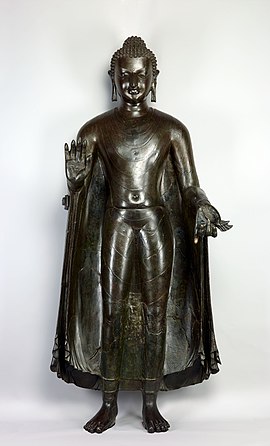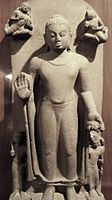Sultanganj Buddha
| Sultanganj Buddha | |
|---|---|
 | |
| Year | 500–700 AD |
| Medium | Copper |
| Movement | Gupta–Pala transitional period |
| Dimensions | 2.3 m × 1 m (91 in × 39 in) |
| Location | Birmingham Museum and Art Gallery, Birmingham |
The Sultanganj Buddha is a
, England.Over life-size, this is "the only remaining metal statue of any size" from
In Lalitpur, Nepal the Guita Bahī monastery has a copper Buddha about 1.8 metres tall, of Nepali make and style, of about the 9th or 10th century. This remains in place, and in worship, against a wall at the end of a shrine or prayer-hall, and the Sultanganj Buddha was probably originally placed in a similar location.[5]
The style of the Sultanganj figure is comparable to slightly earlier stone Buddha figures from Sarnath in "the smoothly rounded attenuation of body and limbs" and the very thin, clinging body garment, indicated in the lightest of ways. The figure has "a feeling of animation imparted by the unbalanced stance and the movement suggested by the sweeping silhouette of the enveloping robe".[3]
Description
The Sultanganj Buddha was cast in pure, unrefined copper by the cire perdue, or lost wax, technique. Inside there is a clay body, mixed with rice husks that allowed radiocarbon dating.[6] The figure stands in the "Fearless Posture", with his right hand raised in abhayamudra (a gesture of reassurance or protection), and his left hand is held downwards with palm outwards, said to indicate granting a favour. The end of the monastic robe is held between the thumb and forefinger of this hand in the manner that is still practised by Theravadin monks.
The surface of the metal is now dark, and "displays over much of its surface a black encrustation of fine clay minerals, which are the result of the long period exposure to atmospheric agents and the burial", except where museum visitors had touched the fingers of the
The sheer size of the statue meant that "the workshop which was in charge of casting the ‘Sultanganj Buddha’ worked at the limit of its technical capabilities", and various stages of repairs and a "secondary casting" (at a rather lower level of skill) were carried out to complete and perhaps maintain the statue.[5]
Date
The sculpture was originally dated to the Gupta period, Vincent Arthur Smith specifying around 400 in a book of 1911.[7] Then dates as late as 800 came to be preferred. The results of the radiocarbon dating suggest 600–650,[6] though the museum still prefers "500–700".[8]
Discovery and later history

E. B. Harris, the railway engineer who discovered the Buddha during excavations that he carried out on ancient remains near the Sultanganj station that he was constructing, published a detailed account of his work, complete with a site plan and photographs. He describes finding the right foot of the Buddha ten feet under the surface, beneath a floor he considered to have been used to conceal the statue after it had been toppled from its former place.[9] Harris sent the statue to Birmingham, the cost of its transport to England being paid by Samuel Thornton, a Birmingham manufacturer of ironmongery. Thornton, himself a former mayor of Birmingham, offered it to the Borough Council for their proposed Art Museum in 1864. In Birmingham, a town that boasted a thousand trades, the Art Museum was intended to be an exemplar and inspiration for local metalworkers and other artisans.
Over the years, it has been shown in a number of prominent locations throughout
From 1998 to 2015, the Buddha was the centrepiece of a gallery at Birmingham Museum and Art Gallery dedicated to displaying a number of Buddhas and related artefacts, and Birmingham Museum held an annual 'Buddha Day', when West Midlands-based Buddhist groups from a range of traditions would bless the statue.
During 2015, Birmingham Museum and Art Gallery worked with representatives of a number of faith groups from the city on the creation of a new 'Faith Gallery', and the Sultanganj Buddha was moved from its previous location. It is now displayed in a new gallery that tells the story of the range of faiths that are practiced in Birmingham.
Gallery
-
Sultanganj Buddha
-
Indian Museum, Kolkata, 5th century, from Sarnath
-
Indian Museum, Kolkata, 5th century, from Sarnath
-
Buddha from Mathura, dated 434
Notes
- ^ "BBC – Birmingham – Faith – The Sultanganj Buddha". www.bbc.co.uk.
- ^ Wingfield, Christopher (2010). Touching the Buddha: Encounters with a charismatic object. In Museum Materialities: Objects, Engagements, Interpretations, ed. Sandra H. Dudley, Routledge: London & New York. pp. 53–70.
- ^ a b Rowland, 237
- ^ Rowland, 237–239
- ^ a b c Graldi
- ^ a b Harle, 212
- ^ Smith, Vincent Arthur (1911). A history of fine art in India and Ceylon, from the earliest times to the present day. Oxford: Clarendon Press. p. 171.
- ^ a b "Buddha – The Sultanganj Buddha – Birmingham Museums & Art Gallery Information Centre". www.bmagic.org.uk.
- ^ Harris, E. B. (1864) Description of Buddhist Remains Discovered at Sooltangunge, London: privately published.
- ^ "figure | British Museum". The British Museum.
- ^ "Asian Art Museum Online Collection". searchcollection.asianart.org.
- ^ "Head of the Buddha (Figure) | V&A Search the Collections". V and A Collections. May 16, 2020.
References
- Graldi, Aurora, "With a face of ‘red copper’: new insights on the over life-size Buddha of Guita Bahī, Lalitpur, and the alteration of the face through technical enhancement" (Draft version on academia.edu), 2018
- Harle, J.C., The Art and Architecture of the Indian Subcontinent, 2nd edn. 1994, Yale University Press Pelican History of Art, ISBN 0300062176
- Rowland, Benjamin, The Art and Architecture of India: Buddhist, Hindu, Jain, 1967 (3rd edn.), Pelican History of Art, Penguin, ISBN 0140561021
External links
 Media related to Sultanganj Buddha (Birmingham) at Wikimedia Commons
Media related to Sultanganj Buddha (Birmingham) at Wikimedia Commons




